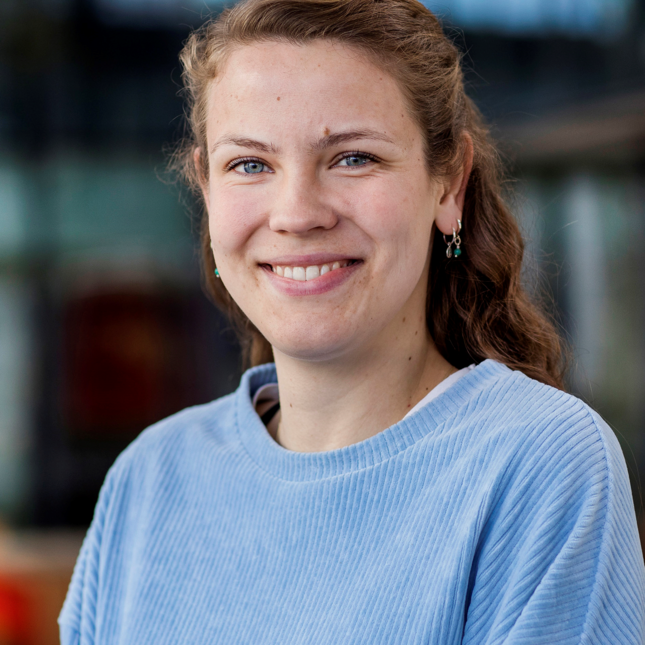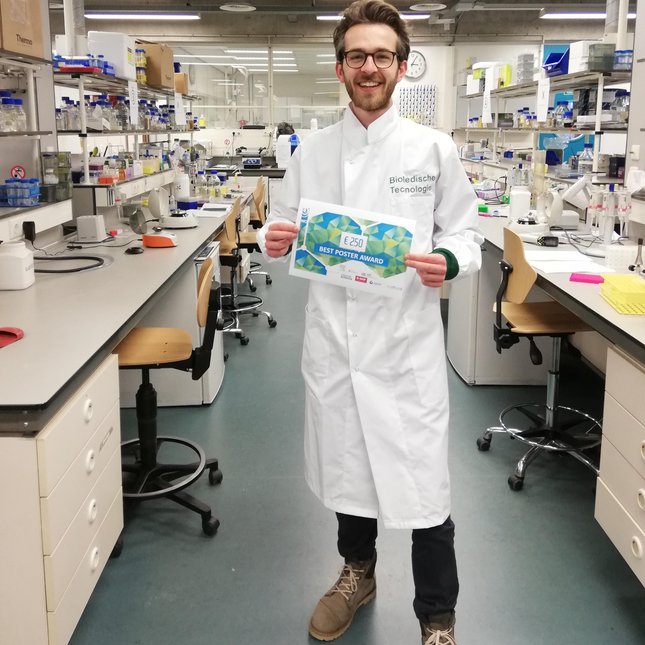Harm and Eva
Harm van der Veer is a Master's student of Biomedical Engineering at TU/e, graduating in the Protein Engineering research group. During his studies, he was part of a team of 11 students who represented TU/e at the international Genetically Engineered Machine (iGEM) competition in 2019. Harm is now building on the foundations of the innovative project initiated by the team. He is working within an overarching project that also involves PhD student Eva van Aalen. Eva has a Bachelor's degree in Medical Sciences and Technology and a Master's in Biomedical Engineering, and previously conducted research into the development of bioluminescent protein sensors that detect biomarkers. If you are not familiar with the field, do read on and find out more! At its heart, it's a project that will make it much easier to detect microbiological pathogens, and therefore to diagnose contagious illnesses, such as Covid-19.

It started with a student competition
In 2019, Harm and Eva were two of a group of students who traveled to Boston for the Giant Jamboree at the iGEM competition, where they presented a concept that used light to detect viruses. Briefly (and much too simply) explained, the method boils down to this: a medium contains sensor proteins that are designed to react to certain elements of viruses. The addition of bodily fluids containing these virus particles causes a reaction whereby the sensor proteins emit light. Hence indicating the presence of a virus.
This may be familiar to readers of the Funds’ 2019 annual report: the work of Professor Maarten Merkx and his research group discussed in the report formed the foundations for Eva, Harm and their iGEM teammates’ project. Together with several other specialists from TU/e, they are currently conducting research into methods of detecting biological pathogens using light. Working on this project allows them to expand their knowledge and give their talents free rein. What's more, they can do so within a field that is in keeping with their personal motives and how they see their future in science. In this double interview, Eva and Harm introduce their work.
DNA detection
“Professor Merkx recognized the potential of our iGEM project and suggested developing it further. It has turned out to be an even better concept than we first thought. It feels special to be integral to a development like this,” says Harm, who is graduating with the project and continuing work on the subject for his PhD. He talks passionately about the project: “We are essentially building biological sensors, in this case sensors that can detect genetic material (DNA/RNA). We can use the sensors to quickly reveal the presence of all sorts of pathogens, even at low concentrations. We are currently developing a system such as this for use in diagnosing SARS-CoV-2.”
Measuring antibodies
One of Eva's focuses is on the development of serological tests. She makes sensors that detect the presence of specific antibodies produced in response to the SARS-CoV-2 virus, which causes Covid-19. It all comes down to how our immune system responds to an infection. This response triggers the production of antibodies. The bodily fluid of someone who has been infected is added to the sensor. This contains proteins that are designed to react with the antibodies and to subsequently emit a certain type of light. From the color of the light, researchers can tell whether antibodies to counteract the virus are present, and if so, how many there are. They can therefore determine whether someone may be protected against a second infection by the virus.
In the beginning
Eva introduces another part of the project: “With all of the sensors of this kind, we are still in the early stages of what ultimately needs to become a ‘point-of-care’ solution, a device that can be used at locations where people receive treatment, for example at a doctor's surgery, or even at a patient's home. For these tests, we need a bodily fluid”. Eva: “You normally measure the concentration of antibodies in blood plasma, the liquid that is left over when blood is centrifuged. This method presents a challenge: the presence of lots of other proteins in blood plasma is counterproductive for measurements with our light sensors. Some of these proteins absorb light, which impacts the results. We are currently trying to solve this problem. We are already seeing positive results if we dilute the blood plasma or introduce an additional calibration step.”
Synthetic biology
Harm and Eva's work is all about biological components, i.e. sensors based on a clever combination of organic elements. Harm admits that this is not what ‘technology’ initially brought to mind. “As a child, the term conjured up images of metal and batteries, that sort of thing. But in the world of molecular biology, you can also make a device, if you combine the correct biochemical components. In this case, natural components, many of which have been amended over a period of years by colleagues to make them more suitable for this purpose.” He describes these amendments as managed evolution. “We aim for useful mutations, some of which we may be able to use.”

Microfluidic chips
For the application of these sensors in a point-of-care diagnostic system, Eva is working in Professor Jaap den Toonder's research group on small devices in which the biochemical reaction can take place and the light can be read out. “We are currently looking at paper-based solutions: a piece of paper soaked in proteins that produce a photo response when liquid is added. I would like to move towards microfluidic chips. These are chips that can analyze small amounts of liquid. The blood ‘crawls’ through the little channels in the chips unaided, thanks to capillary action. (Capillarity is the ability of liquids to move through tiny tubes without the assistance of external forces.) In this way, the liquid touches the sensors and then flows on to the substrate (the substance that enables the sensor to emit light). It arrives in a chamber where a photograph can be taken. The color visible on the photo provides us with information about the amount of what we are looking for, such as antibodies, antigens, RNA or DNA. I think it's a fascinating subject, so after my PhD I would like to continue working in this field in the business community.
Across the world
“Point-of-care application is our ultimate aim,” explains Harm. “We want to create a biochemical system contained in a small device that is portable and can be used across the world. The test can, for example, be based on a small amount of saliva or blood plasma. Moving forward, the tests should even work with modern smartphone cameras. This means shelf life is particularly important. In the lab, we can closely monitor everything, and we have special freezers, but you ideally want to be able to store the biological sensors at room temperature for a while. We are exploring the possibility of freeze-drying, for example, or impregnating paper with our sensor liquid, like Eva mentioned. That would boost shelf life enormously.”
Learning beyond the curriculum
Eva thinks that an especially attractive aspect of studying at TU/e is that you have the chance to learn beyond the curriculum of your degree program. “You can take a whole range of courses at the university. On integrity, for example, or to improve your writing skills, or on how to deal with setbacks. And master's students have plenty of opportunities to conduct truly high-quality research. I have the idea that it's particularly these ‘extracurricular’ activities that help to shape you, both as an individual and as a scientist. And do not underestimate the importance of something as simple as meeting someone for coffee. That's how you get to know people and gain new insights.” She also sees areas for personal growth: “I would like to improve my presenting and writing skills. I know that there are courses for this. Perhaps they could be a little more actively promoted.”
Long live the Fund
Research of this kind relies heavily on funding from the TU/e Fund. As Harm confirms: “It's thanks to the Fund that we have the required components, for example. It is our funding. A fun fact: as I already mentioned, this project has its roots in a student team competition. And it is thanks to the Fund that we were able to compete. A fine example of an opportunity for talent development. And look where we are now; from a student project, a sensor system is born, a system with masses of potential.”
Also support the projects of the heroes of the future. Donate to the University Fund and have your name immortalized on a Heroes’ Arch.